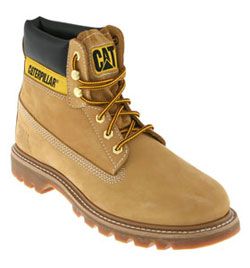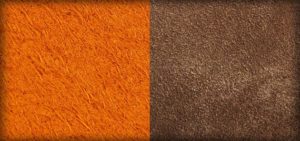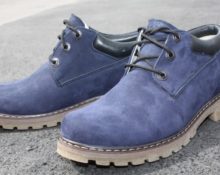The same model of boots can be simultaneously presented in suede and nubuck. Moreover, from a distance or in a photograph, both options will look almost the same. Despite the visual similarity, such products are quite different from each other in terms of operational properties. To choose correctly between them, you should learn to distinguish between them and learn their weak and strong points. So how can you tell them apart?
What kind of material is suede?
 This is genuine leather taken from deer, elk or small livestock. Today, even pork suede is offered on the market, but initially it was created only from chamois.
This is genuine leather taken from deer, elk or small livestock. Today, even pork suede is offered on the market, but initially it was created only from chamois.
To impart the necessary hairiness to the base, the material is subjected to special processing, during which the raw material is impregnated with fatty compounds of plant, formaldehyde-animal and animal origin.. The latter option is considered somewhat outdated and is more consistent with the technologies for producing classic suede fabric.
Important! There is lint-free suede. To make it, you need to take cod oil and deer skin, and also change the processing process, eliminating the fluffing stage.
Fundamental properties of the material:
- softness;
- pronounced velvety;
- subtlety;
- breathability;
- elasticity.
Hairiness is inherent not only on the front side, but also on the back side. With some exceptions, suede fabric is double-sided. It will not be possible to identify its front half visually and by touch.
Characteristics of nubuck
 This is a material of natural animal origin (obtained from the skins of cattle). The front side is covered with fine lint, but there is none on the back side. Nubuck has a velvety feel to the touch, but this property is not as pronounced as suede. The reason is the length and density of the villi.
This is a material of natural animal origin (obtained from the skins of cattle). The front side is covered with fine lint, but there is none on the back side. Nubuck has a velvety feel to the touch, but this property is not as pronounced as suede. The reason is the length and density of the villi.
There are 3 types of nubuck:
- natural;
- nubuck oil;
- synthetic.
The first one is more expensive than artificially created products and has relatively good breathability. The second goes through a series of additional treatments that give it excellent water-repellent qualities. However, these impregnations are very heavy.
Important! High-quality nubuck oil is not a synthetic material. Is this genuine leather.
What is the difference between suede and nubuck?
Key differences:
 Price. Items made from natural nubuck are more expensive than suede (items from the same price and status categories are compared).
Price. Items made from natural nubuck are more expensive than suede (items from the same price and status categories are compared).- Moisture resistance. The quality is higher in nubuck oil.
- Wear resistance. With proper care, nubuck is stronger than suede products.
- Flexibility. In this regard, suede is better.
- Method of receipt. For suede fabric, the skins of small animals are taken, and for nubuck, the skins of cattle are used.
Differences are also visible in relation to substitutes. Compared to its natural counterpart, high-quality artificial suede is attractive because it is easier to handle. It is less deformed under the influence of water and liquid dirt. Therefore, shoes made from it can almost always be machine washed.
If natural suede does not tolerate prolonged contact with water, and artificial suede has a weak moisture resistance, while unnatural nubuck and nubuck oil practically do not absorb water at all. Models made from them can be walked in slush and, with rare exceptions, there are no special requirements for drying them.
Important! Nubuck oil cannot be confused with suede products. The latter has a strong velvety feel. When you touch the first one, it seems that the product is wet or greasy. This effect is explained by the application of a large number of impregnations.
Nuances: what is the difference between nubuck and suede in shoes?
 Shoes made of natural nubuck, impregnated with moisture-repellent compounds, with proper care, will last longer than suede models that have gone through exactly the same treatment.. The difference between service life will be most noticeable in regions that receive frequent rain and a lot of dirt. There is nothing more destructive to suede than liquid mud.
Shoes made of natural nubuck, impregnated with moisture-repellent compounds, with proper care, will last longer than suede models that have gone through exactly the same treatment.. The difference between service life will be most noticeable in regions that receive frequent rain and a lot of dirt. There is nothing more destructive to suede than liquid mud.
If your lifestyle does not involve long walks or you live in a place where there is rarely slush, it makes sense to buy a pair of good natural suede. In a dry climate, to maintain its appearance, it only needs anti-salt, impregnation and a brush to remove dust. For nubuck, the list of care products is somewhat wider. In addition, stubborn stains are a little more difficult to remove from it than from suede.
Important! Good suede cannot be cheap.If shoes made from this material are sold at a very low price, then most likely the model is made of velor or an artificial material that imitates suede.
It is also noteworthy that Suede is used in the manufacture of insoles, but nubuck is usually not used in this role. The same can be said about orthopedic products. Medical shoes can be made from suede fabric, but you will have to try very hard to find a similar nubuck model. This is explained by the fact that the first material is hygienic and conducts air well. The skin breathes in it. This quality is much less pronounced in nubuck.


 Price. Items made from natural nubuck are more expensive than suede (items from the same price and status categories are compared).
Price. Items made from natural nubuck are more expensive than suede (items from the same price and status categories are compared). 0
0





